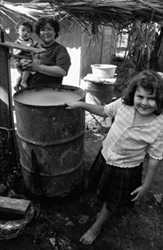|
|

|
Dr.
John Snow and the Drinking Water Discovery >
 The
Water People Drink The
Water People Drink
For people
who live in developed countries, safe drinking water is as close as the
nearest tap. However, many people in developing countries are not so
fortunate.
The World
Health Organization estimates that over one billion people depend on
water from unsafe sources -- rivers, lakes, and shallow wells -- that
are often contaminated with human waste and other pollutants. Because
water sources may be far from home, many people must transport water
long distances and store the water in the home. Water may become contaminated
during transport and storage through direct contact with unclean hands
or dirty containers.
The consequences
of drinking unsafe water include disease and death. Every year, an estimated
two to three million children under five years of age die of diarrhea,
about 6,000 deaths a day.
 Hauling
Water Hauling
Water
Many people
in the developing world do not have water available in or near their
houses. Therefore, they must travel to the source to collect water and
carry it home. Often, women and children must walk several miles to and
from the water source -- a process that may take several hours.
People use
a variety of containers for water transport such as plastic buckets,
clay pots, reused plastic jugs, and even hollowed-out bamboo poles. If
the containers are dirty or the water is touched by unclean hands, the
water may become contaminated.
Water
Storage
After water
has been collected at the source and hauled home, it must be stored until
it is used.  Like
water transport vessels, storage containers can very greatly in shape,
style, and material. Like
water transport vessels, storage containers can very greatly in shape,
style, and material.
The type
of container matters. A container with a narrow mouth and a tap protects
the water. When water is stored in a wide-mouthed container, it is easy
to scoop our a drink with a cup. If either the hand or the cup is not
clean, it may contaminate the water. Therefore, water stored in wide-mouthed
containers is particularly at risk for contamination.
The
Safe Water System
The Centers
for Disease Control and Prevention and the Pan American Health Organization/World
Health Organization have developed a simple, inexpensive method of making
water safe in the home. This method is called the Safe Water System.
The Safe Water System has three parts:
- Water
treatment with a locally-made, dilute bleach solution.
- Safe water
storage in narrow-mouth containers with lids, and, if possible, a tap.
- Behavioral
change techniques, including social marketing, community organization,
and motivational interviewing to improve hygiene habits.
By the year
2015, the United Nations' Millennium Development Goal for Water aims
to reduce by half the percentage of the world's population without safe
water. If this goal is met, it will be a remarkable achievement, but
hundreds of millions of people will still lack safe water. The Safe Water
System is one way to help close this gap. Please visit the Safe
Water System site for more information on the program.
|


